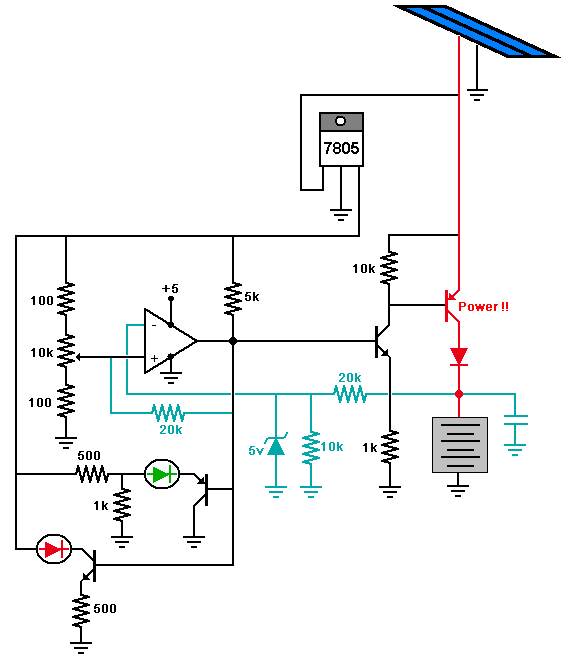| Disclaimer:The following are my notes. As I am learning electronics, I am making my notes available. I hope they will be of benefit. However, I do not guarantee the accuracy of my work. I recommend the reader exercise critical thinking.
|
Schematic 1
Version 1
My first version builds on the previous concepts.
A few additional items are necessary. This version
will be customized for a 12 volt lead acid battery.
But, I will still use a 7805 regulator.
Schmitt Trigger
The comparator must have a Schmitt trigger. Without this,
when the voltage of the battery voltage increases to the cut-off point
the comparator will cause the charging system to quickly oscillate between
charging and charged states.
The cut-on point and cut-off points for a 12 Volt led-acid battery should be
about 13.0 and 14.4, respectively. A Schmitt trigger of about 20k should allow
for this 1.4 Volt range.
Voltage Divider
Since this model uses a 7805 regulator, we need to scale down the voltage
of the battery before we compare against our reference. A scale of 1:3
will allow us to measure voltages up to 15 volts.
A 200 kOhm and 100 kOhm would provide the appropriate scale.
The LM339 chip should not receive any voltage greater than the source
provided to the chip. Just for the sake of safety, I added a 5 volt
Zener to prevent this from happening. Since we use a 200 kOhm between
the comparator and the battery, the Zener should carry only micro amps
under the worst-case scenario. But, the reverse bias saturation current
of the Zener will significantly lower the voltage of the wire.
A 20 kOhm and 10 kOhm will provide the appropriate scale, but will draw a
little more power from the battery. But, this is less than 1 mAmp. The
reverse bias saturation current of the Zener will not adversely impact
the measurement.
Current Limit
The 330 Ohm resistors are removed from this schematic since the full power
of the solar panel is within the C/10 range of the battery.
Capacitor
The capacitor beside the battery is there to prevent the system from
quickly oscillating between charge and charging when the battery is removed.
Since the capacitor stores the charge, it will provide a high
reference for the comparator
...until drained by the 30 kOhm of resistance.
Schematic
Here is the schematic.

Problems
What happens when only 6 volts is provided by the solar panel?
The regulator should receive two volts more than the target voltage.
I found this to be an interesting challenge.
|